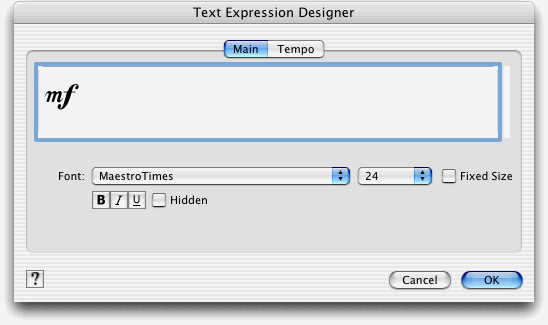Text Expression Designer-Main

How to get there
Click the Expression tool  , and double-click a measure. (If you want to edit a text
expression that’s already in the score, double-click its handle.) Choose the desired category on the left and click
Create, or click an expression and then click Edit.
, and double-click a measure. (If you want to edit a text
expression that’s already in the score, double-click its handle.) Choose the desired category on the left and click
Create, or click an expression and then click Edit.
What it does
In this dialog box, you can create a new
Text Expression or edit an existing one. This dialog box is separated
into two tabs. Use options under the Text tab to edit the spelling and
font, and options under the Tempo tab to apply a tempo indication for
playback.
- [Text
editor window]. The text editor window is where you type the expression
text itself, which appears in the actual font(s) you’ve chosen. You can
see the current font displayed directly below the text editor window.
The Edit and Text menus are available when
the Text tab is chosen so you can copy and paste text, change fonts and
styles, and carry out other editing tasks. The Text Menu commands include
items that control character settings, such as the font, style and inserts,
as well as positioning within the text editor window. Items under the
Text Menu in the Text Expression Designer are identical to corresponding
items under the Text tool’s Text Menu. See Text
Menu in the Text tool chapter for details.
- Insert Note. Use this button to select a note, such as Œ or Ó, in order to specify a metronome marking (e.g. Œ=120). Note that for tempo marks, Finale applies the metronome marking you type to playback automatically so long as the Match Playback to Metronome Marking Text check box is checked under the Tempo tab. See Text Expression Designer-Tempo dialog box.
- Font. Use this popup menu to switch between entering text and musical symbols.
- Hidden. Select this checkbox to prevent the expression from printing. Hidden expressions will continue to display on-screen marked by shading.
- OK
· Cancel. Click OK (or press return) to return to the Expression Selection
dialog box, where your new (or edited) text expression appears in the
list (in the font you’ve specified)—or to return to the score. Note that
when you edit an expression, your editing will affect every occurrence
of the marking in the score. Click Cancel to return to the Expression
Selection dialog box (or to the score) without creating or editing a
text expression.
See Also
Text Expression Designer-Tempo dialog box


![]() , and double-click a measure. (If you want to edit a text
expression that’s already in the score, double-click its handle.) Choose the desired category on the left and click
Create, or click an expression and then click Edit.
, and double-click a measure. (If you want to edit a text
expression that’s already in the score, double-click its handle.) Choose the desired category on the left and click
Create, or click an expression and then click Edit.